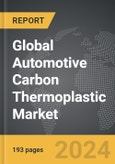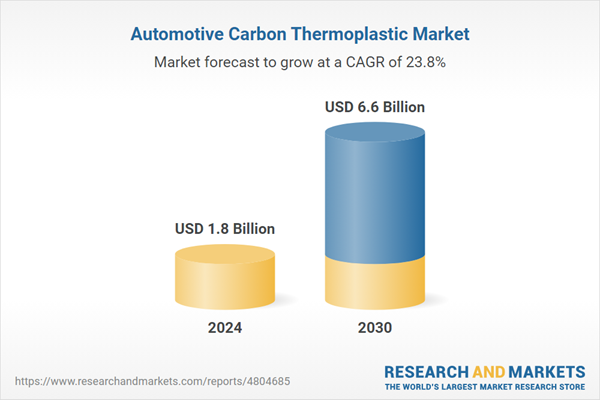Global Automotive Carbon Thermoplastic Market - Key Trends and Drivers Summarized
Why Are Automotive Carbon Thermoplastics Revolutionizing Vehicle Manufacturing?
Automotive carbon thermoplastics are transforming the vehicle manufacturing industry by providing a combination of lightweight properties and high strength, essential for improving fuel efficiency and performance. These materials, composed of carbon fibers embedded in a thermoplastic matrix, are gaining popularity in the automotive sector for their ability to reduce vehicle weight without compromising safety or durability. In an era where regulations on emissions and fuel consumption are becoming stricter, automakers are increasingly turning to carbon thermoplastics to meet these demands. By reducing the overall weight of vehicles, carbon thermoplastics contribute to better fuel efficiency, lower emissions, and improved handling dynamics. Beyond traditional fuel-powered vehicles, these materials are particularly important in electric vehicles (EVs), where reducing weight can enhance battery performance and extend driving range. From structural components such as chassis and body panels to interior features, carbon thermoplastics are reshaping the way cars are built, providing a high-performance alternative to metals and other heavier materials.How Are Technological Innovations Boosting the Use of Carbon Thermoplastics in the Automotive Industry?
Technological advancements have significantly enhanced the application and production of carbon thermoplastics, making them more accessible and efficient for automotive use. One key innovation is the development of faster production techniques, such as compression molding, which allows for the rapid production of complex automotive parts with carbon thermoplastic materials. This has helped to reduce manufacturing cycle times, making these materials more viable for high-volume automotive production. Furthermore, advancements in automation and robotics have streamlined the processing of carbon thermoplastics, ensuring greater precision and repeatability in the manufacturing of lightweight, high-strength components. Another major technological leap has been the development of hybrid carbon thermoplastic composites that combine different materials to improve mechanical properties such as stiffness and impact resistance. These hybrid composites enable automotive engineers to fine-tune the performance of vehicle components, optimizing weight savings and strength for specific applications like crash structures or energy absorption zones. Additionally, innovations in bonding technologies have improved the integration of carbon thermoplastics with traditional automotive materials like steel and aluminum, enhancing the structural integrity of multi-material designs. These advancements in materials science and manufacturing processes are driving the wider adoption of carbon thermoplastics in automotive design, making it possible to scale production while maintaining the performance benefits of these advanced composites.What Market Trends and Challenges Are Shaping the Automotive Carbon Thermoplastic Industry?
Several key trends are shaping the automotive carbon thermoplastic market as automakers continue to seek out materials that offer superior performance and sustainability. One significant trend is the increasing use of carbon thermoplastics in electric vehicles (EVs), where weight reduction is critical to maximizing battery efficiency and extending driving range. As the global shift toward electrification accelerates, the demand for lightweight materials like carbon thermoplastics is expected to rise. Another trend is the growing emphasis on sustainability in the automotive industry, with manufacturers increasingly adopting carbon thermoplastics because they can be more easily recycled than traditional thermoset composites. Thermoplastics can be reheated, reshaped, and reused, aligning with the industry's move towards circular economy models and reducing waste in vehicle production. Despite these promising trends, the automotive carbon thermoplastic market faces several challenges, particularly in terms of cost and manufacturing complexity. Carbon fiber materials are still expensive to produce, which drives up the overall cost of carbon thermoplastic components compared to traditional materials like steel or aluminum. Additionally, the processing of carbon thermoplastics requires specialized equipment and expertise, which can limit adoption, especially among smaller automotive manufacturers. Another challenge is the need for more efficient recycling and end-of-life solutions for carbon thermoplastics, as the technology for large-scale recycling of these materials is still in its infancy.What Are the Factors Driving the Growth of the Automotive Carbon Thermoplastic Market?
The growth in the automotive carbon thermoplastic market is driven by several factors, including technological advancements, regulatory pressures for improved fuel efficiency, and the rise of electric vehicles. One of the primary drivers is the increasing demand for lighter, stronger materials to help automakers meet stringent emissions regulations. Carbon thermoplastics offer a significant advantage in this regard, as they can reduce vehicle weight, leading to improved fuel economy and lower greenhouse gas emissions. In electric vehicles, the importance of weight reduction is even more pronounced, as lighter cars require less energy to drive, extending battery life and improving overall performance. This has spurred automakers to incorporate carbon thermoplastics in structural and non-structural components, further driving demand. Technological advancements in material science and manufacturing processes have also played a critical role in the market's growth. Innovations in hybrid carbon thermoplastics and new production methods, such as automated molding and bonding techniques, have made it easier and more cost-effective to integrate these materials into mainstream automotive production. Additionally, the automotive industry's increasing focus on sustainability has bolstered the adoption of carbon thermoplastics, as they offer the potential for recyclability and reduced environmental impact compared to other composite materials. Furthermore, as automotive manufacturers continue to prioritize safety, carbon thermoplastics are gaining attention for their ability to absorb energy in crash situations, offering enhanced protection for passengers while contributing to overall vehicle weight reduction.Report Scope
The report analyzes the Automotive Carbon Thermoplastic market, presented in terms of market value (USD). The analysis covers the key segments and geographic regions outlined below.- Segments: Resin Type (Polyamide (PA), Polypropylene (PP), Polyphenylene Sulfide (PPS), Polyetherimide (PEI), Polyetheretherketone (PEEK), Polycarbonate (PC)); Application (Exterior, Chassis, Interior, Powertrain & UTH).
- Geographic Regions/Countries: World; United States; Canada; Japan; China; Europe (France; Germany; Italy; United Kingdom; Spain; Russia; and Rest of Europe); Asia-Pacific (Australia; India; South Korea; and Rest of Asia-Pacific); Latin America (Argentina; Brazil; Mexico; and Rest of Latin America); Middle East (Iran; Israel; Saudi Arabia; United Arab Emirates; and Rest of Middle East); and Africa.
Key Insights:
- Market Growth: Understand the significant growth trajectory of the Exterior Application segment, which is expected to reach US$1.9 Billion by 2030 with a CAGR of 22.7%. The Chassis Application segment is also set to grow at 24% CAGR over the analysis period.
- Regional Analysis: Gain insights into the U.S. market, valued at $456.4 Million in 2024, and China, forecasted to grow at an impressive 29.8% CAGR to reach $1.8 Billion by 2030. Discover growth trends in other key regions, including Japan, Canada, Germany, and the Asia-Pacific.
Why You Should Buy This Report:
- Detailed Market Analysis: Access a thorough analysis of the Global Automotive Carbon Thermoplastic Market, covering all major geographic regions and market segments.
- Competitive Insights: Get an overview of the competitive landscape, including the market presence of major players across different geographies.
- Future Trends and Drivers: Understand the key trends and drivers shaping the future of the Global Automotive Carbon Thermoplastic Market.
- Actionable Insights: Benefit from actionable insights that can help you identify new revenue opportunities and make strategic business decisions.
Key Questions Answered:
- How is the Global Automotive Carbon Thermoplastic Market expected to evolve by 2030?
- What are the main drivers and restraints affecting the market?
- Which market segments will grow the most over the forecast period?
- How will market shares for different regions and segments change by 2030?
- Who are the leading players in the market, and what are their prospects?
Report Features:
- Comprehensive Market Data: Independent analysis of annual sales and market forecasts in US$ Million from 2024 to 2030.
- In-Depth Regional Analysis: Detailed insights into key markets, including the U.S., China, Japan, Canada, Europe, Asia-Pacific, Latin America, Middle East, and Africa.
- Company Profiles: Coverage of players such as BASF SE, Celanese Corporation, Cytec Industries, Inc., Dow, Inc., DuPont de Nemours, Inc. and more.
- Complimentary Updates: Receive free report updates for one year to keep you informed of the latest market developments.
Some of the 44 companies featured in this Automotive Carbon Thermoplastic market report include:
- BASF SE
- Celanese Corporation
- Cytec Industries, Inc.
- Dow, Inc.
- DuPont de Nemours, Inc.
- Gurit Holding AG
- Koninklijke Ten Cate BV
- Quickstep Holdings Limited.
- Saudi Basic Industries Corporation (SABIC)
- SGL Group - The Carbon Company
- Teijin Ltd.
- Toray Industries, Inc.
This edition integrates the latest global trade and economic shifts into comprehensive market analysis. Key updates include:
- Tariff and Trade Impact: Insights into global tariff negotiations across 180+ countries, with analysis of supply chain turbulence, sourcing disruptions, and geographic realignment. Special focus on 2025 as a pivotal year for trade tensions, including updated perspectives on the Trump-era tariffs.
- Adjusted Forecasts and Analytics: Revised global and regional market forecasts through 2030, incorporating tariff effects, economic uncertainty, and structural changes in globalization. Includes historical analysis from 2015 to 2023.
- Strategic Market Dynamics: Evaluation of revised market prospects, regional outlooks, and key economic indicators such as population and urbanization trends.
- Innovation & Technology Trends: Latest developments in product and process innovation, emerging technologies, and key industry drivers shaping the competitive landscape.
- Competitive Intelligence: Updated global market share estimates for 2025, competitive positioning of major players (Strong/Active/Niche/Trivial), and refined focus on leading global brands and core players.
- Expert Insight & Commentary: Strategic analysis from economists, trade experts, and domain specialists to contextualize market shifts and identify emerging opportunities.
Table of Contents
Companies Mentioned (Partial List)
A selection of companies mentioned in this report includes, but is not limited to:
- BASF SE
- Celanese Corporation
- Cytec Industries, Inc.
- Dow, Inc.
- DuPont de Nemours, Inc.
- Gurit Holding AG
- Koninklijke Ten Cate BV
- Quickstep Holdings Limited.
- Saudi Basic Industries Corporation (SABIC)
- SGL Group - The Carbon Company
- Teijin Ltd.
- Toray Industries, Inc.
Table Information
| Report Attribute | Details |
|---|---|
| No. of Pages | 193 |
| Published | December 2025 |
| Forecast Period | 2024 - 2030 |
| Estimated Market Value ( USD | $ 1.8 Billion |
| Forecasted Market Value ( USD | $ 6.6 Billion |
| Compound Annual Growth Rate | 23.8% |
| Regions Covered | Global |









